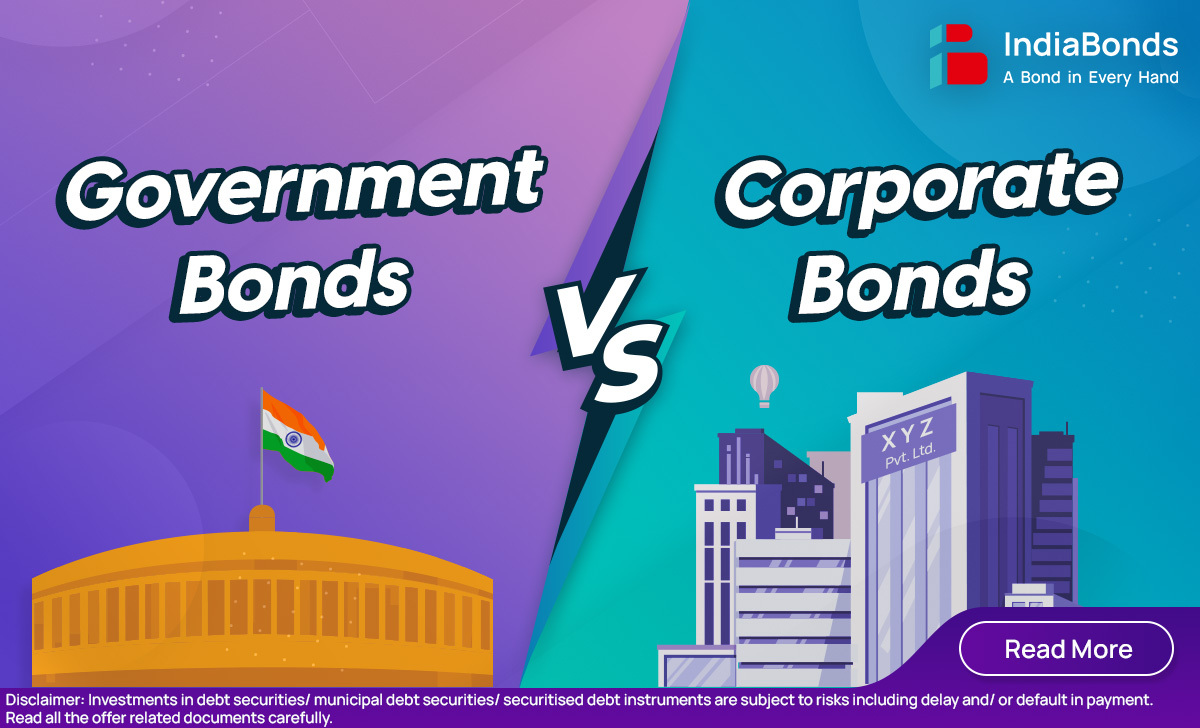Government Bonds vs. Corporate Bonds

The only free lunch in finance is diversification – Harry Markowitz
How impactful is the quote by the Nobel Prize laureate and pioneer of the Modern Portfolio Theory in today’s world? Portfolio diversification is at the heart of a successful investment strategy. By spreading investments across various assets, one can navigate the ups and downs of the investment journey and achieve respectable returns. Whether the objective is to accumulate wealth or preserve capital, maintaining a well-balanced asset mix is crucial. Fixed income securities, in particular, provide a sense of security and stability. When included in one’s investment portfolio, they form a solid foundation for financial investments. As an investor, you have a plethora of choices when constructing your portfolio. No single instrument surpasses another or guarantees exceptional returns on its own. However, by combining different instruments in the right proportions, you can reduce your portfolio’s vulnerability to market risks. In fact, the portfolio concentration is directly linked to an investor’s perspective on financial markets. If you aim to create a diversified portfolio, it’s imperative not to overlook the importance of including corporate and government bonds. These bonds are the giants of the fixed-income securities. This article aims not to compare their pros and cons but to provide a comprehensive overview of these instruments. This knowledge will empower you to make informed decisions when selecting the right asset mix for your portfolio.
What are Corporate Bonds?
Companies issue bonds to raise funds for operational expansion and other business needs. When you invest in a corporate bond, you’re lending money directly to a company. The returns on corporate bonds generally outpace those of government bonds, reflecting the associated higher risks. Meticulous creditworthiness assessments of the companies issuing these bonds are crucial for prudent investment decisions. One of the key advantages of investing in corporate bonds is the potential for higher yields compared to government bonds. Since corporate bonds carry credit risk, investors demand a higher return to compensate for the additional risk. As a result, corporate bonds typically offer higher yields, making them attractive to income-seeking investors. Examples may include NCDs, bonds issued by MFIs, NBFCs, HFCs, etc.
Example of a Corporate Bond
Let’s take the example of an NCD (Non-Convertible Debenture) issued by a company. Suppose the company issues a secured NCD offering a fixed interest rate of 8.75% per annum with a tenure of 3 years. Investors who subscribe to this bond receive regular interest payments (monthly, quarterly, or annually, depending on the issuance terms) and the principal amount upon maturity. The NCD is listed on the stock exchange, offering liquidity if the investor wants to exit before maturity. Such corporate bonds are typically rated by agencies like CRISIL or ICRA, which help investors assess the credit risk involved. These bonds are an example of how private companies raise capital directly from investors instead of taking loans from banks.
What are Government Bonds?
Government bonds or more popularly known as government securities (gsecs) are issued by the Reserve Bank of India (RBI). Indian government both central and state requires funds to meet its fiscal expenditure. By investing in these bonds, you are essentially lending your money to the government for a prescribed period in return for guaranteed interest payments. Their unwavering reliability, stemming from governmental backing, renders them a haven for risk-averse investors. They can be considered risk-free instruments in the Indian financial markets and serve as benchmarks for pricing other debt instruments. Financial institutions, banks, mutual funds, and pension funds also invest in government securities. Examples of government bonds in India include Dated Government Securities, Treasury Bills, Cash Management Bills, State Development Loans, Sovereign Gold Bonds (SGB), etc.




Example of a Government Bond
Consider the 7.26% Government Security (G-Sec) maturing in 2033. This bond is issued by the Government of India and pays 7.26% interest annually to bondholders. It is considered one of the safest investment options due to the sovereign backing. Investors receive semi-annual coupon payments and the full principal at the end of the 10-year tenure. G-Secs like this one are listed on exchanges and can be bought or sold before maturity. This is a common choice for risk-averse investors, including banks, insurance firms, and increasingly, retail participants through platforms like RBI Retail Direct or online bond marketplaces.
Key Differences between Government and Corporate bonds
| Aspect | Government Bonds | Corporate Bonds |
| Issuer | Indian Government | Indian Private Corporations |
| Risk | Lowest within the debt securities space | Varying levels, dependent on the company’s creditworthiness |
| Returns | Relatively lower | Potentially higher to compensate for risk |
| Liquidity | Highly liquid | Varies based on the specific company and bond |
| Taxation | Tax benefits applicable for certain bonds such as tax-free and SGBs | Interest is taxable |
Types of Government Bonds
- Treasury Bills (T-Bills): Short-term bonds with maturities of 91, 182, or 364 days.
- Dated Government Securities (G-Secs): Long-term bonds with fixed or floating interest, typically ranging from 5 to 40 years.
- State Development Loans (SDLs): Bonds issued by state governments with similar characteristics to G-Secs.
- Sovereign Gold Bonds (SGBs): Bonds issued against grams of gold, offering fixed interest and potential gold price appreciation.
- Inflation-Indexed Bonds (IIBs): Provide returns linked to inflation, protecting investors from rising price levels.
Advantages and Disadvantages of Government Bonds
Advantages:
- Backed by the government, thus low default risk
- Predictable income through fixed coupon payments
- Suitable for long-term financial planning
- Eligible for collateral in repo transactions
Disadvantages:
- Lower yields compared to corporate bonds
- Interest income is taxable
- Long tenure may lead to interest rate risk if sold before maturity
- Limited price appreciation in a falling interest rate environment
Types of Corporate Bonds
- Secured Bonds: Backed by the issuer’s assets; lower risk.
- Unsecured Bonds: No collateral; higher risk but higher return potential.
- Convertible Bonds: Can be converted into equity shares of the issuing company.
- Perpetual Bonds: No maturity date; pays interest indefinitely.
- Callable/Puttable Bonds: Issuer or investor has the option to redeem early.
Advantages and Disadvantages of Corporate Bonds
Advantages:
- Higher interest rates than government bonds
- Wide variety of options across sectors and tenures
- May offer regular income via monthly or quarterly coupons
- Customizable features (call/put, convertible) to suit investor needs
Disadvantages:
- Higher credit/default risk depending on issuer rating
- Limited liquidity in some cases
- May not be suitable for risk-averse investors
- Interest income is taxable
Which One Should You Choose?
Choosing between government bonds and corporate bonds depends on your investment goals, risk tolerance, and time horizon. If safety and capital preservation are your top priorities, government bonds—especially G-Secs and SDLs—offer peace of mind with sovereign backing. On the other hand, if you’re aiming for higher returns and are comfortable with moderate risk, corporate bonds, particularly those from high-rated issuers, can provide better yields. Many investors opt for a mix of both to balance stability with growth. It’s also worth considering factors like tenure, credit ratings, interest payout frequency, and liquidity before making your decision. With online platforms simplifying access, retail investors now have more tools than ever to make informed choices aligned with their financial plans.
Conclusion
We are currently experiencing a time when technology has revolutionized investing. With the emergence of seamless cutting-edge technology, individuals can construct their own portfolios online and seek guidance from a financial advisor when necessary. Furthermore, by leveraging this flexibility, investors can align their bond portfolios with their risk tolerance, investment objectives, and income requirements. The combination of the ultimate safety of government bonds and the high yield of corporate bonds may result in a ‘risk-free inflation-adjusted return.’ Focusing solely on one asset class or investing based on ‘tips’, trading without any strategy exposes your capital to various risks. However, achieving an appropriate asset mix tailored to your financial goals and time horizon is a key to successful investing. It’s not just about asset classes; investors can also diversify across sectors, geographical regions, companies, and credit quality. Whether it’s comparing corporate vs government bonds or constructing an ideal portfolio mix, investors should aim for diversification rather than simply chasing returns.
FAQS
1. What is the main difference between government bonds and corporate bonds?
Government bonds are issued by the central or state government to fund public expenditure and are considered low-risk due to sovereign backing. Corporate bonds are issued by private or public companies to raise capital for business operations and generally offer higher returns but come with credit risk.
2. Are corporate bonds riskier than government bonds in India?
Corporate bonds are subject to the issuing company’s financial health and market conditions. Government bonds, especially those issued by the central government, carry negligible default risk.
3. Corporate bonds vs government bonds ; which is better?
A. Government bonds are generally considered safer due to backing by the government, offering stability but lower yields. Corporate bonds, on the other hand, often provide higher yields but come with relatively higher risk as they depend on the issuing company’s financial health. The choice between the two depends on investor risk tolerance and investment goals.
4. Who should invest in government bonds vs. corporate bonds?
Risk-averse investors looking for stable and safe returns may prefer government bonds. Investors seeking higher yields and willing to take on moderate credit risk may consider high-rated corporate bonds. A balanced portfolio can include both based on the investor’s risk profile.
5. How are government and corporate bonds taxed in India?
Interest earned from both government and corporate bonds is taxed as per the investor’s income tax slab. If bonds are sold before maturity, capital gains tax applies:
- Short-term gains: taxed at the slab rate.
- Long-term gains: taxed at 10% without indexation (if listed), or 20% with indexation (if unlisted).
6. Are corporate bonds suitable for short-term or long-term investment?
Corporate bonds are available across both short and long tenures. Short-term corporate bonds (1–3 years) are suitable for liquidity and moderate returns. Long-term bonds (5+ years) may offer better yields but come with interest rate and credit risk.
7. Can retail investors in India buy both government and corporate bonds easily?
Yes. With the rise of online bond platforms and initiatives like RBI Retail Direct, retail investors can now easily invest in both government and corporate bonds. Minimum investment starts from as low as ₹10,000 on platforms like IndiaBonds.
Disclaimer: Investments in debt securities/ municipal debt securities/ securitised debt instruments are subject to risks including delay and/ or default in payment. Read all the offer related documents carefully.



















































